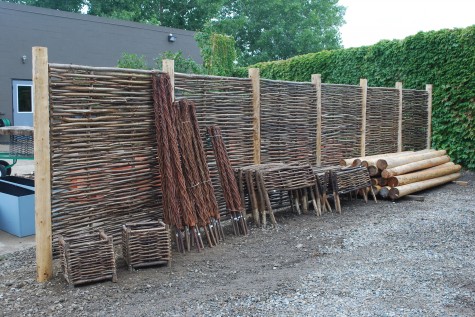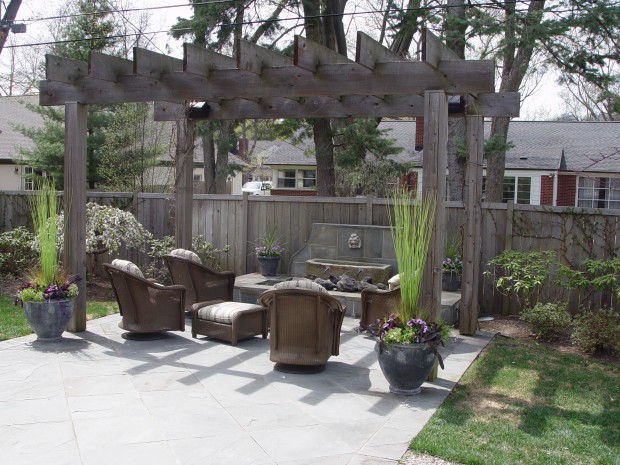
A fence is a garden structure that is easy to identify. A fence is a vertical element in a garden that separates one space from another. Twin fences with soil piled in between is an effective noise barrier. How so? Only soil absorbs and blocks sound. Plants and single layer fences do nothing to mitigate sound. An impossibly tall berm at the road is a fence of a green sort. It separates a personal and quiet space from a noisy and public space by filtering out the sound. Many communities permit the installation of what is known as a privacy fence. No matter the material, any fence of a substantial height (in this case, 6′ tall) provides a physical separation from adjacent properties. Those people who live in urban areas value their privacy. A fence is a simple structure that takes up very little space-in the interest of establishing a boundary. Your yard and my yard have a barrier in between that allows each of us to live our private lives.
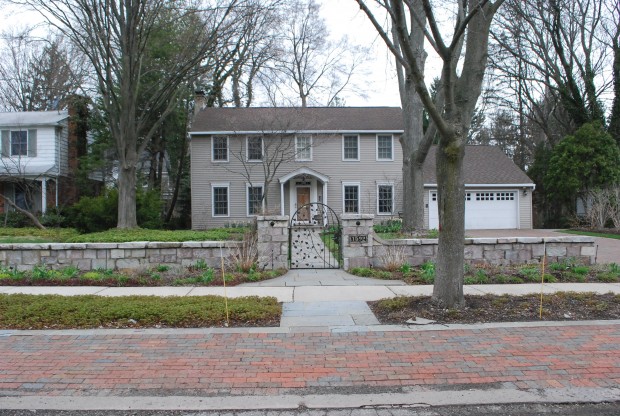
Those people who live on vast ranges of land in Texas value a separation that keeps their cattle from wandering off their property. Electrical substations fence their properties to keep unsuspecting others from injuring themselves. The Berlin wall was an elaborate fence which came to symbolize a barrier to freedom. A firewall on my computer-a digital fence constructed to protect my computer from harm. A fence is a person who is a middleman between two parties. The fence is a barrier, or a facilitator, depending on the circumstances. Other fences are purely decorative in how they define a space. A low wall, should it be long enough, qualifies as a fence. This wall/fence does not provide privacy. It does not entirely enclose a space. It makes a beautiful and very friendly statement about the separation between the public street and the private home.

Iron fences designate a separation, but permit lots of light, and a view through. These pillars are massive, and the gate is solid and painted a dark color. The black iron fence can barely be seen, but for the hedge of yews planted on the inside. Why so much discussion about this particular fence? The choice of materials, the color, and the size make a visual statement about privacy.
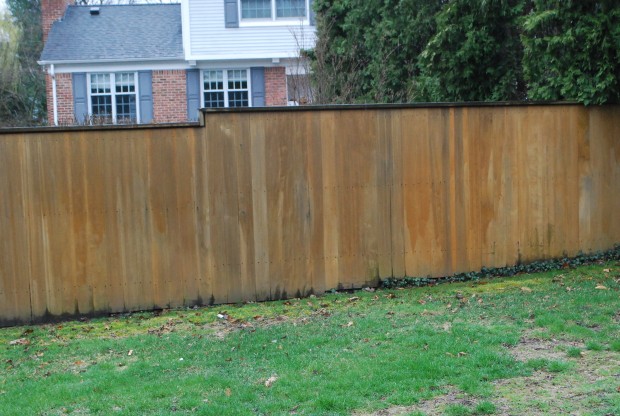
Like the home in the previous picture, this property is a corner property. Other homes on the block have private back yards courtesy of the house itself. This fence is solid from top to bottom, and has a very contemporary feeling. Make sure that wood fence is installed slightly elevated from the ground plane. A garden fence made of wood needs to shed water and dry quickly. A fence in constant contact with the soil will deteriorate much sooner than it needs to.

This second floor balcony terrace has a fence which is primarily about safety. White or light colored fences usually stand out architecturally, but this fence has a landscape of water and sky behind it. This white fence in a green landscape would make a much more emphatic architectural statement.
This vegetable garden is entirely enclosed by a fence of cedar, and galvanized steel mesh. The idea here is to protect herbs and vegetables from the wildlife. The height of the fence is meant to keep the deer out. The depth of the wire fencing below ground is meant to deter ground hogs and rabbits. Keep out.
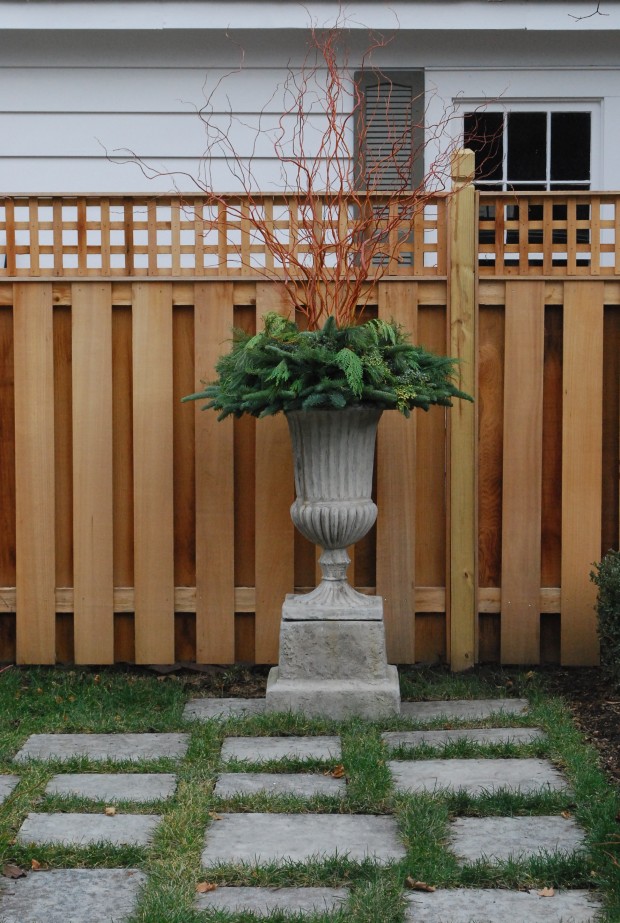
Fences of a clearly decorative design satisfy the need for beauty and visual interest as much as a need for privacy. Cedar is a highly rot resistant and evenly grained wood that can make a fence as refined in appearance as a piece of furniture. The design of this fence is especially pleasing, given the stone and grass path below.
Espaliered trees can provide a green fence. In a tight space that needed screening up high, a fence of espaliered lindens was a good solution. The property next door is vacant, and unattended-the property line is in front of the boulders. Were it to be sold and developed, a new house could be very close by. Anticipating the need for privacy permits the time it takes for a green fence to grow. The major horizontal arms have numerous small branches which will eventually grow together to form a green wall. This fence needs more care than most, in the form of yearly, or twice yearly pruning.
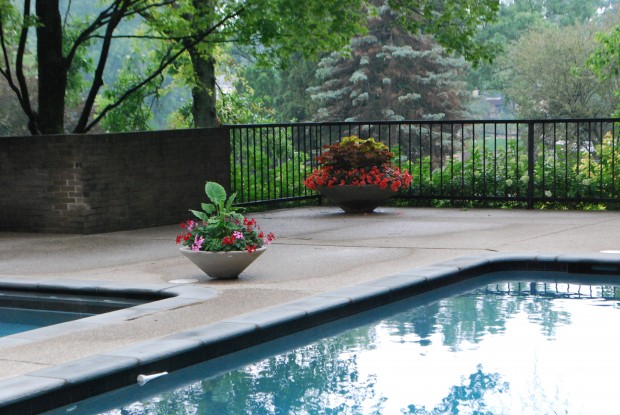
Pools require fences of a certain height, and a certain density. An iron pool fence in my area requires a picket every 4 inches. Most communities have rules about fencing swimming pools, as they can be dangerous to a child. These fences are not about privacy-they are about safety. The hydrangeas on the far side of the fence will eventually grow between the pickets. The fence itself will disappear from view, with its ability to enclose and protect unimpeded.
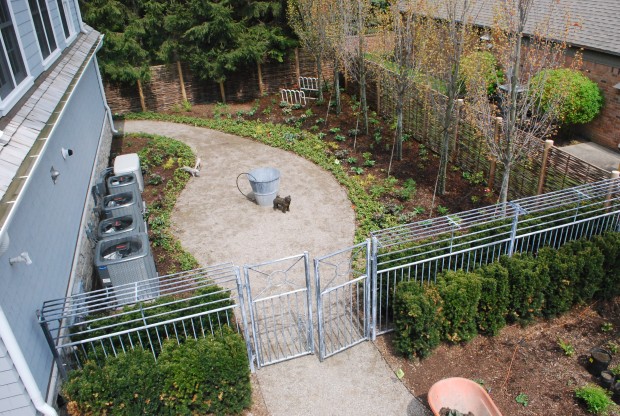
This garden/dog run has a hazel wood privacy fence along 2 lot lines. The Bowhall maples will eventually provide a green screen for the second floor windows. The iron fence encloses the dog run, and is meant to deter coyotes. Coyotes run at, and leap over a barrier. The 18″ wide shelf at the top of the fence, and the yew hedge at the bottom, is a strong deterrent.
I have only seen a fence such as this once. It is beautiful and dense. Fencing from natural materials are easy on the gardening eye while entirely functional.
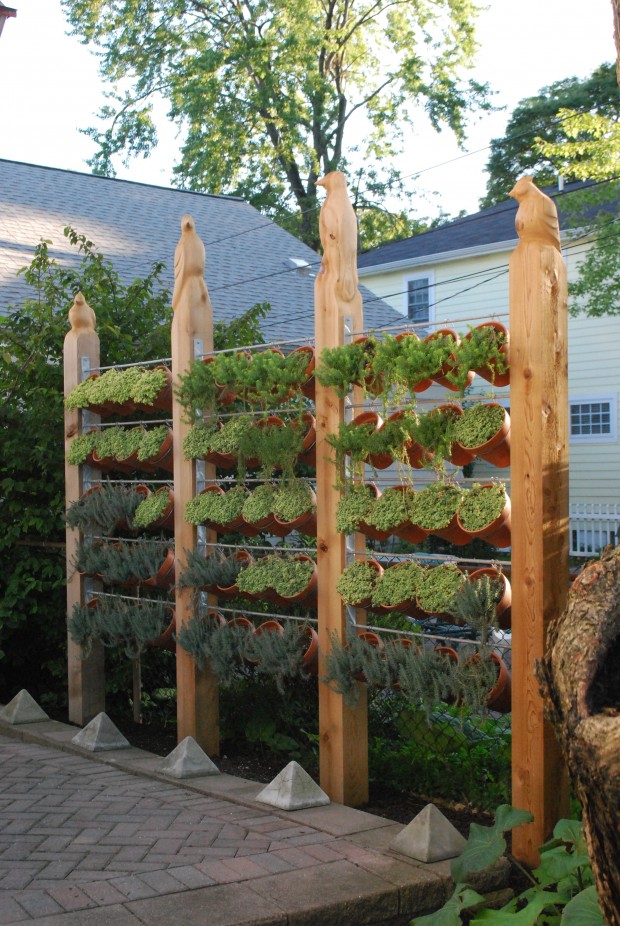 But of any fence I have ever seen, this has to be one of the most inventive and original. Designed and built by Barry Harrison, partner in Art-Harrison Design Studio in Royal Oak, it satisfies both a need for privacy and a need for green. The cedar posts with integral bird finials were hand carved by Barry himself. It’s easy to see that these pots of succulents would be tough to overwater. This is sure evidence that even the most utilitarian element in a landscape can have great visual appeal.
But of any fence I have ever seen, this has to be one of the most inventive and original. Designed and built by Barry Harrison, partner in Art-Harrison Design Studio in Royal Oak, it satisfies both a need for privacy and a need for green. The cedar posts with integral bird finials were hand carved by Barry himself. It’s easy to see that these pots of succulents would be tough to overwater. This is sure evidence that even the most utilitarian element in a landscape can have great visual appeal.

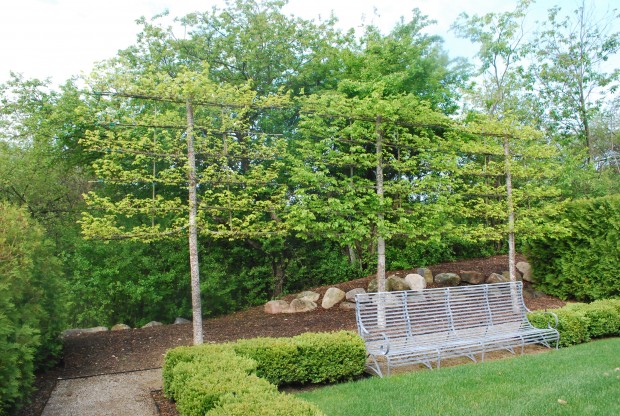
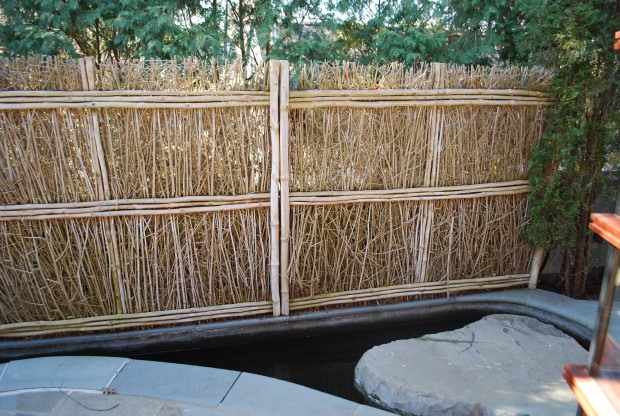
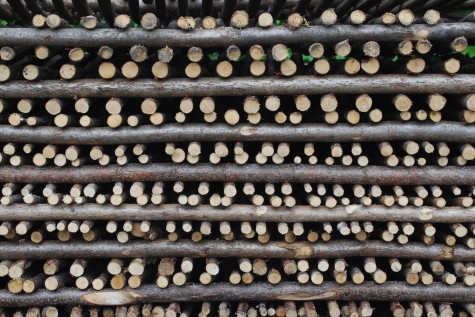 I wrote a few days ago regarding my excitement about the delivery of a container load of hazel wood hurdles from Belgium; the order we placed in May finally arrived. Wattles and hurdles are panels, woven from the coppice wood of willow and hazel wood. I personally favor the heft and longevity of the hazel wood; it is vastly more durable and substantial than willow. Coppicing is the practice of cutting trees or shrubs to the quick, with the intent of harvesting the branches for fuel, or fencing. The shrub or tree regrows, only to have its branches harvested again. Woven hurdles keep the livestock out of the vegetable garden. They border herb and vegetable gardens. They provide privacy without being utterly opaque. They work wherever they are needed. Woven hurdles are a fence material friendly to a garden or landscape of any point of view.
I wrote a few days ago regarding my excitement about the delivery of a container load of hazel wood hurdles from Belgium; the order we placed in May finally arrived. Wattles and hurdles are panels, woven from the coppice wood of willow and hazel wood. I personally favor the heft and longevity of the hazel wood; it is vastly more durable and substantial than willow. Coppicing is the practice of cutting trees or shrubs to the quick, with the intent of harvesting the branches for fuel, or fencing. The shrub or tree regrows, only to have its branches harvested again. Woven hurdles keep the livestock out of the vegetable garden. They border herb and vegetable gardens. They provide privacy without being utterly opaque. They work wherever they are needed. Woven hurdles are a fence material friendly to a garden or landscape of any point of view. I have a client who has become a friend; he supports Michigan industry in a big way and was so pleased these stripped cedar fence poles we bought are Michigan grown. Though I ordered 5″ diameter poles, 10 feet long, they looked like telephone poles when they got delivered from a supplier in Michigan’s Upper Peninsula. As I relentlessly speak to issues of proportion, I was worried I had gone over the edge by an inch. I was wringing my hands, until the fence went up. I should not have worried. The size of the pole was perfect for the heft and texture of the fence. The bare cedar poles are a good contrast to the woven hazel wood, which has all of its bark intact.
I have a client who has become a friend; he supports Michigan industry in a big way and was so pleased these stripped cedar fence poles we bought are Michigan grown. Though I ordered 5″ diameter poles, 10 feet long, they looked like telephone poles when they got delivered from a supplier in Michigan’s Upper Peninsula. As I relentlessly speak to issues of proportion, I was worried I had gone over the edge by an inch. I was wringing my hands, until the fence went up. I should not have worried. The size of the pole was perfect for the heft and texture of the fence. The bare cedar poles are a good contrast to the woven hazel wood, which has all of its bark intact.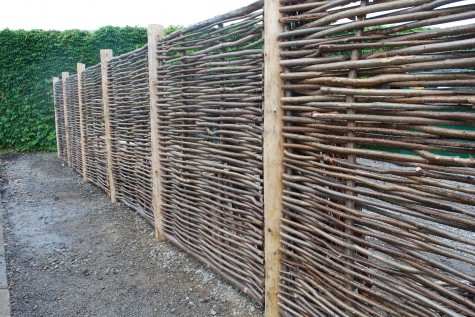 There is no substitute for the time when the talk ends, and the making begins. We set a pole down 24″ or so below grade, and set a panel up next to it. These panels are made by hand, and vary in width somewhat. One pole, one panel, and so on. This one step at a time construction ensures that the space between two poles is fitted to a specific panel. Steve toe-nail screwed the panels to the center of each post; this is a sturdy construction. What I like even better? This fence has no back or front; the panels are the same back and front. How friendly is this to neighboring properties? This fence looks good to both sides.
There is no substitute for the time when the talk ends, and the making begins. We set a pole down 24″ or so below grade, and set a panel up next to it. These panels are made by hand, and vary in width somewhat. One pole, one panel, and so on. This one step at a time construction ensures that the space between two poles is fitted to a specific panel. Steve toe-nail screwed the panels to the center of each post; this is a sturdy construction. What I like even better? This fence has no back or front; the panels are the same back and front. How friendly is this to neighboring properties? This fence looks good to both sides.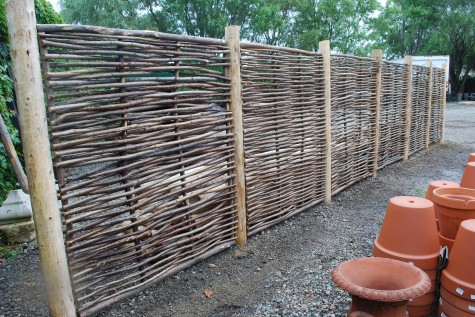 I have a client who plans to screen his hot tub with this fencing. It was the subject of intense debate today-will these hurdles screen a man who is happily skinny dipping? I vote yes-unless the neighbor plans to be close enough to see through the hurdle branches. The neighbor with his nose pressed to the fence-that is the subject of another essay, is it not? The fence is also friendly to vines that need to grip to climb. Clematis grown on this fence is especially lovely. We are careful to install the fence slightly above the existing grade of the ground. Wood in constant contact with soil will deteriorate much more quickly than wood that is able to shed water.
I have a client who plans to screen his hot tub with this fencing. It was the subject of intense debate today-will these hurdles screen a man who is happily skinny dipping? I vote yes-unless the neighbor plans to be close enough to see through the hurdle branches. The neighbor with his nose pressed to the fence-that is the subject of another essay, is it not? The fence is also friendly to vines that need to grip to climb. Clematis grown on this fence is especially lovely. We are careful to install the fence slightly above the existing grade of the ground. Wood in constant contact with soil will deteriorate much more quickly than wood that is able to shed water.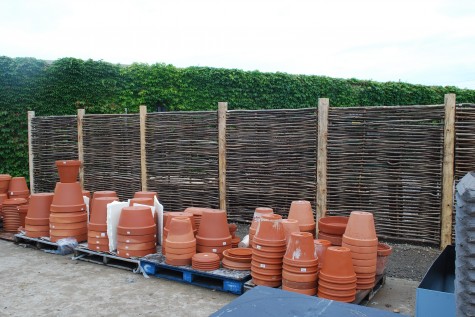 The fence is good looking with contemporary steel ornament, traditional terra cotta pots, a funky birdbath made from recycled materials, or a formal lead cistern fountain. This is by way of saying this fence looks good with almost anything. As to its longevity, imagine how long it takes a dead tree to fall and deteriorate. Branches and twigs are not good materials for the compost pile, as they break down so slowly. We have stocked this fencing for 8 years now. I have yet to have someone tell me it had disintegrated. Wood fences do age though-that is part of their charm.
The fence is good looking with contemporary steel ornament, traditional terra cotta pots, a funky birdbath made from recycled materials, or a formal lead cistern fountain. This is by way of saying this fence looks good with almost anything. As to its longevity, imagine how long it takes a dead tree to fall and deteriorate. Branches and twigs are not good materials for the compost pile, as they break down so slowly. We have stocked this fencing for 8 years now. I have yet to have someone tell me it had disintegrated. Wood fences do age though-that is part of their charm.